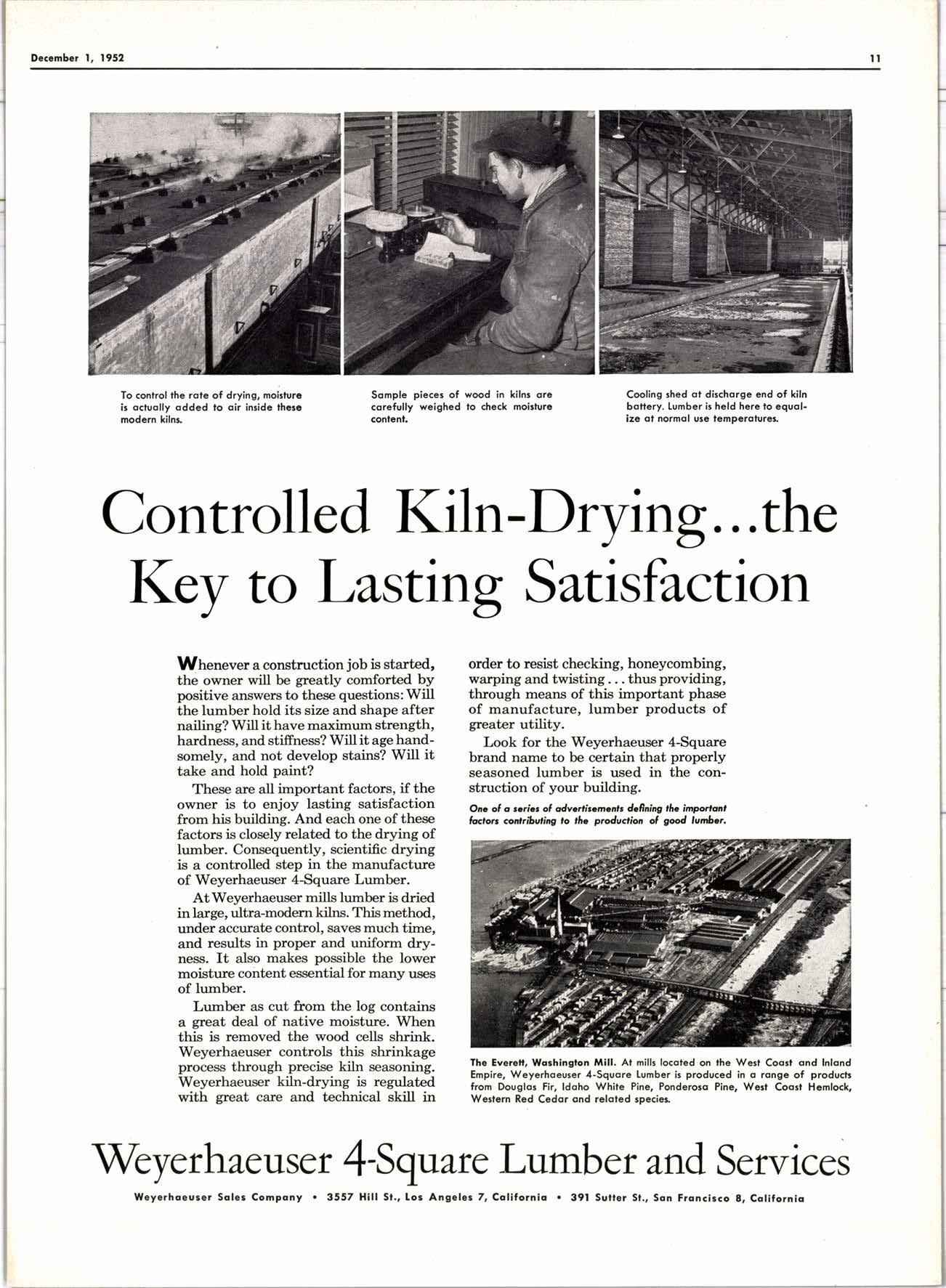
4 minute read
Controlled Kiln-Drying . . .the Kry to Lasting Satisfaction
Wheneve" a construction job is started, the owner will be greatly comforted by positive answers to these questions: Will the lumber hold its size and shape after nailing? Win it have maximum strength, hardness, and stiffness? Willit age handsomely, and not develop stains? Will it take and hold paint?
These ale all important factors, if the owner is to enjoy lasting satisfaction from his building. And each one of these factors is closely related to the drying of lumber. Consequently, scientific drying is a controlled step in the manufactule of Weyerhaeuser 4-Square Lttrnber.
AtWeyerhaeuser mills lumber is dded in large, ultra-modern kilns. This method, under accurate control, saves much time, and results in proper and uniform dryness. It also makes possible the lower moisture coirtent essential for nrany uses of hrmber.
Lurrrber as cut from the log contains a great deal of native moisture. When this is removed the wood cells shrink. Weyerhaeuser controls this shrinkage process through precise kibn seasoning. Weyerhaeuser kiln-drying is regulated with great care and technical skill in order to resist checking, honeycombing, warping and twisting. thus providing, through mearu of this important phase of manufacture, lumber products of greater utility.
Look for the Weyerhaeruer 4-Square brand name to be certain that properly seasoned lumber is used in the construction of your building.
Om oi o so'fu 4 advorristmonb dteaiag rhc inpqla, tarc,rt cortributilg to tho prodvctiut d good brtor.
Resolutions Adopted by Directors of NLMA at Annual Meeting
Washington, November l4-Spokesmen for the nation's lumbermen demanded today that the government keep hands ofi private timber management and build more roads to speed the harvesting of over-aged and damaged federal timber.
These were among the highlights of resolutions adopted by Directors of the National Lumber Manufacturers Associatiorr to climax their 1952 annual meeting in Washington, D. C.
The lumber leaders denounced a recent proposal of the President's Materials Policy Commission which called for federal-state controls on private timber cutting. NLMA insisted that any public regulation of private timber cutting should be left entirely to the states.
The association's 54-man board of directors also urged that the government spend $30,000,000 annually over the next five years for construction of new timber access roads in federal forests. This amount, approximately triple present outlays, was recommended to open up for harvest virgin starnds of federal timber which have been deteriorating in recent years.
The lumber spokesmen added that the government should finance timber road construction only where private building is not feasible and that each project should be subject to a public hearing.
The NLMA directors attacked several recommendations of the President's Materials Policy Commission, headed by CBS Board Chairman William Paley, including its proposal for a system of federal forest loans and insurance.
The industry representatives asserted that forest loans
Six Forest Areas in So. California Taken into Tree Farm Program
California's Southland is one of the latest newcomers into the American Tree Farm System. Six forest properties totaling 10,840 acres were.recently approved for certification by the state forest practice committee of the Western Pine Assn. The new Tree Farms are listed under "New Tree Farmers."
The new batch brings the California Tree Farm total to Il7 units, 1,483,343 acres, in the Western Pine area, making California first in number of units and first in acreage among the 12 states of the region. In addition, California, which is now second in the nation in lumber production, ha.s 110,112 acres of Tree Farms certified under the California Redwood Assn. banner.
Situated in the highlands east and south of Los Angeles, and insurance should be handled exclusively by private banks and insurance firms. (The Paley Commission proposals, made public a few months ago, are being considered by various federal agencies as the basis for possible legislation when Congress reconvenes).
Other NLMA resolutions, suggested by the association's Forest Conservation Committee: some of the new Tree Farms include intensively used recreational areas such as Arrowhead and Big Bear Lakes. Southern California's pine forests cover about 150,000 acres with a total sawtimber stand of about one billion feet. Much of this is being heavily raided by beetles as a result of natural factors combined with concentrated recreational use. The tree farmers are well along on programs to check beetle inroads by harvesting, rather than trying to preserve, over-mature pines; then growing new trees and at a1l times preserving the park-like appearance of the forests. Eight small sawmills, cutting a totalof less than 5,000,000 feet a year, operate in the region largely on "bug tree.s," and much of the lumber is used rightin the recreational area for summer home construction. Timber grows to substantial size. Jeffrey pines six feet in diameter and with 8,000 board feet volume are not uncommon. Coulter pine, sugar pine, incense cedar, white fir, bigcone spruce, black oak, alder and several other species thrive in the region. ro
1. Recommended that state forestry departments levy a service charge (based on production) for technical assistance furnished private forest operators. In this connection, NLMA rejected a Paley Commission proposal that the Agriculture Department eventu.ally be authorized to increase its staff for this work to 2,000 field men and that the cost be borne equally by federal and state governments.
2. Reconrmended that the forest management standards for federal lands be raised to the level maintained on intensively-managed private lands.
3. Called on federal, state and private interests to step up their forest insect and disease research, and to irnprove their detection and control facilities.
4. Suggested that a national forest research advisory council be established to bolster the forest research programs of all federal, state and private agencies. NLMA opposed a Paley Commission proposal that the Agriculture Department's forest research funds be doubled, and insisted that the agency streamline these activities instead.

5. Proposed that state forestry departments encourage private operators to plant more seedlings onidle lands. NI MA insisted, however, that the states should boost their charges fol seedlings to the extent that state and federal subsidies could be eliminated wherever state laws permit.
6. Demanded that the matter of property taxation and special forest tax laws be left entirely to the states.
Working closely with the Southland tree farmers is the Riverside district staff of the State Division of Forestry. One of the division's recent cooperative aids in the area was a widely distributed circular to acquaint thousands of summer home owners with facts of the beetle problem and instruct them how they can best help in control efforts.
-Forestry Digest.


crll our mony friends. .
in genuine oppreciotion we express.our THANKS to you who moke our business possible ond extend lo eoch ond everyone of you ourwishthot your Christmos moy be on enioyoble one, ond the New Yeor hoppy ond prosperous.











